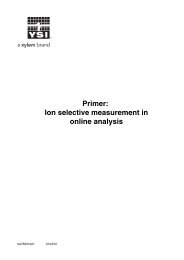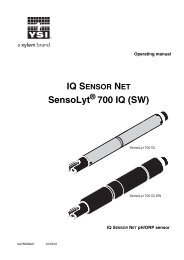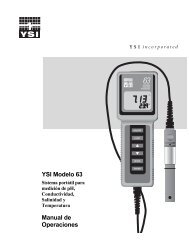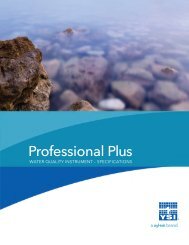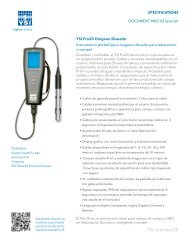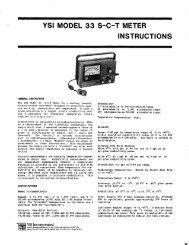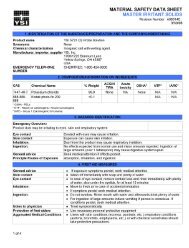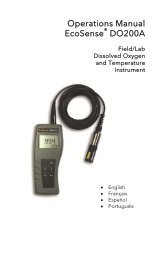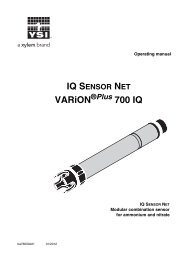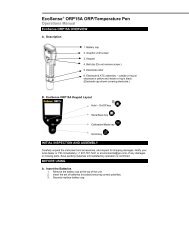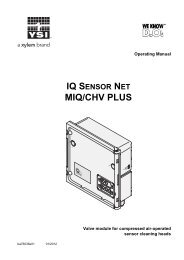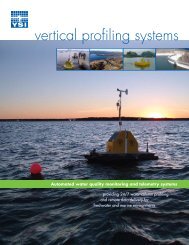Oxygen Probe Electrolyte for Model 5912 5913 5914 - YSI.com
Oxygen Probe Electrolyte for Model 5912 5913 5914 - YSI.com
Oxygen Probe Electrolyte for Model 5912 5913 5914 - YSI.com
You also want an ePaper? Increase the reach of your titles
YUMPU automatically turns print PDFs into web optimized ePapers that Google loves.
MATERIAL SAFETY DATA SHEETRevision Number A96036C03/04/111. IDENTIFICATION OF THE SUBSTANCE / PREPARATION AND THE COMPANY / UNDERTAKINGProduct name <strong>YSI</strong> <strong>Oxygen</strong> <strong>Probe</strong> <strong>Electrolyte</strong> <strong>5912</strong>, <strong>5913</strong>, <strong>5914</strong>SynonymsNoneChemical characterizationSolid, PowderManufacturer, importer, supplier <strong>YSI</strong>, Inc.1700/1725 Brannum LaneYellow Springs, Ohio 45387EMERGENCY TELEPHONE NUMBER (937) 767-72412. COMPOSITION / INFORMATION ON INGREDIENTSCAS Chemical Name % Weight ACGIH TWA Acute Toxicity IARC* NTP* OSHA*7647-14-5 Sodium Chloride 100 NA NA NA NA NA* IARC - Group 1 (Carcinogenic to humans)* NTP - Report on Carcinogens - Known Carcinogens* OSHA - Regulated Carcinogens3. HAZARDS IDENTIFICATIONEmergency OverviewMay cause eye irritationEye ContactSkin ContactInhalationIngestionPrinciple Routes of ExposureModerately irritating to the eyesSubstance may cause slight skin irritationInhalation of dust in high concentration may cause irritation of respiratory system.Ingestion may cause irritation to mucous membranes. May cause gastrointestinaldis<strong>com</strong><strong>for</strong>t if consumed large amounts.Eye contact, skin contact, and ingestion4. FIRST AID MEASURESEye Contact Rinse immediately with plenty of water, also under the eyelids, <strong>for</strong> at least 15minutes. Keep eye wide open while rinsing. Do not rub affected area. If irritationpersists, call a physician.InhalationMove to fresh airIngestionClean mouth with water and afterwards drink plenty of water. Never give anythingby mouth to an unconscious person. Consult a physicianNotes to PhysicianTreat symptomaticallyProtection of First-AidersAggravated Medical Conditions None know5. FIRE-FIGHTING MEASURESFlash PointNot applicableSuitable Extinguishing Media Use extinguishing measures that are appropriate to local circumstances and thesurrounding environment.Special protective equipment <strong>for</strong>firefightersAs in any fire, wear self-contained breathing apparatus pressure-demand,MSHA/NIOSH (approved or equivalent) and full protective gearNFPA (National Fire Protection Association) Health=1 (slight) Reactivity=0 Fire=0 Special=0 (none)HMIS (Hazardous Material In<strong>for</strong>mation System) Health=1 (slight) Reactivity=0 Fire=0 Special=0 (none)MATERIAL SAFETY DATA SHEET – <strong>YSI</strong> <strong>5912</strong>, <strong>5913</strong>, <strong>5914</strong>1 of 4Page
6. ACCIDENTAL RELEASE MEASURESPersonal precautionsMethods <strong>for</strong> cleaning upUse personal protective equipment. Ensure adequate ventilation. Avoid dust<strong>for</strong>mationClean up promptly by sweeping or vacuum. Avoid dust <strong>for</strong>mation. Flush areawith flooding quantities of water. Clean contaminated surface thoroughly.7. HANDLING AND STORAGESafe Handling AdviceStorageHandle in accordance with good industrial hygiene and safety practice. Avoiddust <strong>for</strong>mation. Do not breathe vapors/dust. Avoid contact with eyes.Keep tightly closed in a dry and cool place. Keep in properly labeled containers.8. EXPOSURE CONTROLS / PERSONAL PROTECTIONThis product does not contain any hazardous materials with occupational exposure limits established by the regionspecific regulatory bodies.Engineering measuresPersonal protective equipmentHand ProtectionEye protectionRespiratory ProtectionSkin and Body ProtectionRespiratory ProtectionHygiene measuresEyewash stationsRisk of contact, wear: tightly fitting safety goggles.No special protective equipment requiredNone required under normal usage. Respirator must be worn if exposed todustHandle in accordance with good industrial hygiene and safety practiceGeneral In<strong>for</strong>mationFormAppearanceOdor9. PH<strong>YSI</strong>CAL AND CHEMICAL PROPERTIESGranular solidWhitenoneImportant Health Safety and Environmental In<strong>for</strong>mationpH6.5 – 7.5 (in aqueous solution)Boiling Point / RangeNo data availableFlash PointNo data availableMolecular Weight 58.44Vapor PressureNo in<strong>for</strong>mation availableVapor DensityNo in<strong>for</strong>mation availableWater SolubilityCompletely solubleSpecific Gravity 2.17Melting Point / Range 804 C (1479 F)10. STABILITY AND REACTIVITYStabilityMaterials to AvoidHazardous De<strong>com</strong>position ProductsPolymerizationStable under re<strong>com</strong>mended storage conditionsStrong oxidizing agents; strong acidsNone knownPolymerization does not occurMATERIAL SAFETY DATA SHEET – <strong>YSI</strong> <strong>5912</strong>, <strong>5913</strong>, <strong>5914</strong>2 of 4Page
Acute ToxicityProduct In<strong>for</strong>mationLocal Effects11. TOXICOLOGICAL INFORMATIONProduct does not present an acute toxicity hazard based on known in<strong>for</strong>mationModerately irritating to the eyes. Inhalation of dust in high concentration may causeirritation of respiratory systemChemical Name LD50 Oral LD50 Dermal LC50 InhalationSodium chloride 3g/kg (Rat) 10g/kg (Rabbit) 42g/m3 (Rat) 1 hChronic ToxicityTarget OrganNone knownEcotoxicity Effects12. ECOLOGICAL INFORMATIONEcotoxicity effects.Chemical Name Toxicity to algae Toxicity to fish Microtox Daphnia Magna(water fleas)Sodium Chloride NA NA NA EC50= 1000mg/L 48hProduct In<strong>for</strong>mationAquatic ToxicityNo in<strong>for</strong>mation available.Other In<strong>for</strong>mationMobilityWill likely be mobile in the environment due to its water solubility.Bioaccumulative PotentialDoes not bioaccumulate.Persistence and DegradabilityProduct is not biodegradable13. DISPOSAL CONSIDERATIONSWaste From Residues / Unused ProductsContaminated PackagingThis material, as supplied, is not a hazardous waste according to stateand federal regulations.Empty containers should be taken <strong>for</strong> local recycling, recovery orwaste disposal.14. TRANSPORT INFORMATIONDOTTDGMEXICAOIATAIMDG/IMORIDADRADNNot regulatedNot regulatedNot regulatedNot regulatedNot regulatedNot regulatedNot regulatedNot regulatedNot regulatedMATERIAL SAFETY DATA SHEET – <strong>YSI</strong> <strong>5912</strong>, <strong>5913</strong>, <strong>5914</strong>3 of 4Page
15. REGULATORY INFORMATIONU.S. InventoriesTSCADSLEINECS/ELINCSENCSCHINAKECLPICCSAICSCompliesCompliesCompliesCompliesCompliesCompliesCompliesCompliesU.S. Federal RegulationsSARA 313Section 313 of Title III of the Superfund Amendments and Reauthorization Act of 1986 (SARA). This product does notcontain any chemicals which are subject to the reporting requirements of the Act and Title 40 of the Code of FederalRegulations, Part 372.SARA 311/312 Hazard CategoriesAcute Health HazardChronic Health HazardFire HazardSudden Release of Pressure HazardReactive HazardNoNoNoNoNoClean Water ActThis product does not contain any Proposition 65 chemicals.U. S. State Right-to-Know RegulationsInternational RegulationsMexico – Grade Minimum risk, Grade 0CanadaThis product has been classified in accordance with the hazard criteria of the Controlled Products Regulations (CPR) andthe MSDS contains all the in<strong>for</strong>mation required by the CPR.WHMIS Hazard ClassNon-controlled16. OTHER INFORMATIONIssuing DateRevision Date06-Aug-200716-June-2008End of Safety Data Sheet.MATERIAL SAFETY DATA SHEET – <strong>YSI</strong> <strong>5912</strong>, <strong>5913</strong>, <strong>5914</strong>4 of 4Page



